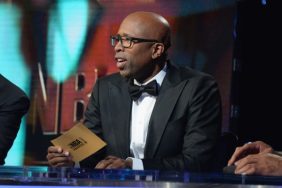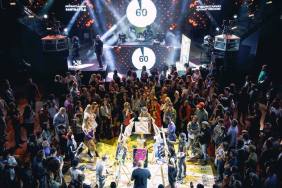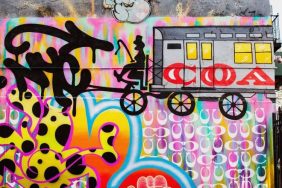Photo: © Danny Lyon. Three boys and “A Train’ graffiti in Brooklyn’s Lynch Park in New York City, June 1974 (detail). Courtesy of Wikimedia Commons.
Art is not a crime—but that doesn’t stop police departments and D.A. offices nationwide from pursuing the capture, arrest, and prosecution of graffiti writers and street artists to make a political point. Crave has compiled a list of some of the most high-profile street art and graffiti arrests in the United States.
Also: TAKI 183, Elusive NY Graffiti Legend, Comes Out of Retirement
KEO, New York (2003)
Never let it be said that the system is on your side. In August 2003, Howard Dean was riding high on the rails, campaigning for President by appealing to the urban voter. One of his aides got the bright idea of creating a graffiti backdrop for a promotional event planned for Manhattan’s landmark Bryant Park, which had been polished and spit-shined to perfection making it the perfect site for such events.
Famed graffiti writer and artist KEO took the job with trepidation, and rightfully so. Dean’s opponents played up graffiti as “the wrong message,” with Mayor Michael Bloomberg leading the charge. The powers-that-be put pressure on the NYPD Vandal Squad and had KEO arrested on one felony count of criminal mischief. Civil rights lawyer Ron Kuby took the case. The city refused to back down, and swaddled KEO with a plea deal that required five years probation.

Centerpiece: Art by Revok. Clinton Park, Mission, San Francisco. Photo by Adamina, courtesy of Wikimedia Commons.
REVOK, Los Angeles (2011)
In 2011, REVOK made headlines after a series of legal troubles caught up with him. It all began at a California music festival in 2009, when he was arrested and took a plea deal for graffiti. A year later, he was arrested in Australia at Melbourne Airport, after local police tracked him down on Twitter. The police brought in news crews to capture the arrest, using the bust as a way to generate press for themselves.
This put local LAPD on his tail stateside. While on his way to Ireland, REVOK was arrested at LAX for failing to pay restitution on an old case. His bail was set at $320,000 and the LAPD issued a press release, treating him like an A-list criminal. It was a full-scale media assault, one that found REVOK sentenced to 180 days in prison—six months—for a mere probation violation.
NEO, New York (2010)
In a case of truth is stranger than fiction, a former NYPD officer, who had retired on a disability pension in 2001, was discovered to be former 1980s graffiti writer NEO. By 2009, NEO was making a comeback, bombing the city with a vengeance—only was it that same person?
The retired NYPD officer claimed it was an imitator. He indicated that he had to use a cane and lacked the agility graffiti writers need to do their work—but the court determined otherwise. In 2010, NEO was found guilty for just one tag. The sentence was steep: he was required to pay a $700 fine, was put on three years probation, his gun license was permanently revoked, and he was required to participate in Brooklyn’s “Paint Straight” art program.

SANESMITH, New York (1988)
In 1998, the legendary graffiti team, brothers SANE and SMITH, hit the top level of the Brooklyn Bridge, writing their name with bucket paint while balancing precariously on a ledge just 18 inches wide, more than 100 feet above the East River.
In a story at Fresh Paint NYC, SMITH recalled, “On reflection, painting a monument such as the Brooklyn Bridge was probably a bad idea since we were unprepared for the consequences….A few days later a newspaper reporter called our house and informed us of the enormity of the deed. Then came a couple of calls by the news media. Sane, the more verbose brother, did an interview with one TV crew, feeling that we should stand up and let our intentions be known. It came out as a sound bite and we saw the futility of trying to get our meanings across in the televised media.”
The City of New York sued the brothers for $3 million, the biggest lawsuit to date against graffiti writers. At trial, late William Kunstler, the legendary civil rights activist and radical lawyer, represented the brothers and the city lost its case.
Michael Jerome Stewart (1983)
On September 15, 1983 at 2:50 a.m., Brooklyn native Michael Jerome Stewart was arrested for spray-painting graffiti inside the First Avenue L train station. Police claim the 135-pound Pratt University art student became violent, and in response, they beat him to unconsciousness. He was booked for resisting arrest and unlawful possession of marijuana, then transported to Bellevue Hospital. He arrived at 3:22 a.m., comatose, hand-cuffed, legs bound, and never regained consciousness. He died two weeks later, on September 28.
According to Chief Medical Examiner Dr. Elliot Gross’s preliminary autopsy report, Stewart had a heart attack that put him in a coma, and died of heart failure afterwards. A physician who witnessed the autopsy on behalf of the family said the cause of death was strangulation. Eleven police officers were involved in the incident; all were white. Stewart was black.
Six officers went to trial for the crime. The first trial was dismissed when it was discovered one of the jurors initiated private investigations into the case. In 1985, the officers were acquitted by an all-white jury. In 1987, the Stewart family brought a lawsuit against the officers and the MTA. In 1990, the city settled out of court in the amount of $1.7 million for the wrongful death of Michael Jerome Stewart.
Stewart’s death has been immortalized in film by the death of Radio Raheem in Spike Lee’s Do the Right Thing, in music by Lou Reed (“Hold On” on New York), and in paintings by Jean-Michel Basquiat and Keith Haring.
Miss Rosen is a journalist covering art, photography, culture, and books. Her byline has appeared in L’Uomo Vogue, Whitewall, The Undefeated, Dazed Digital, Jocks and Nerds, and L’Oeil de la Photographie. Follow her on Twitter @Miss_Rosen.








